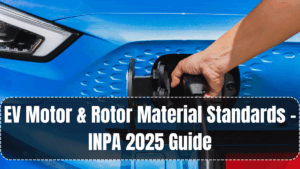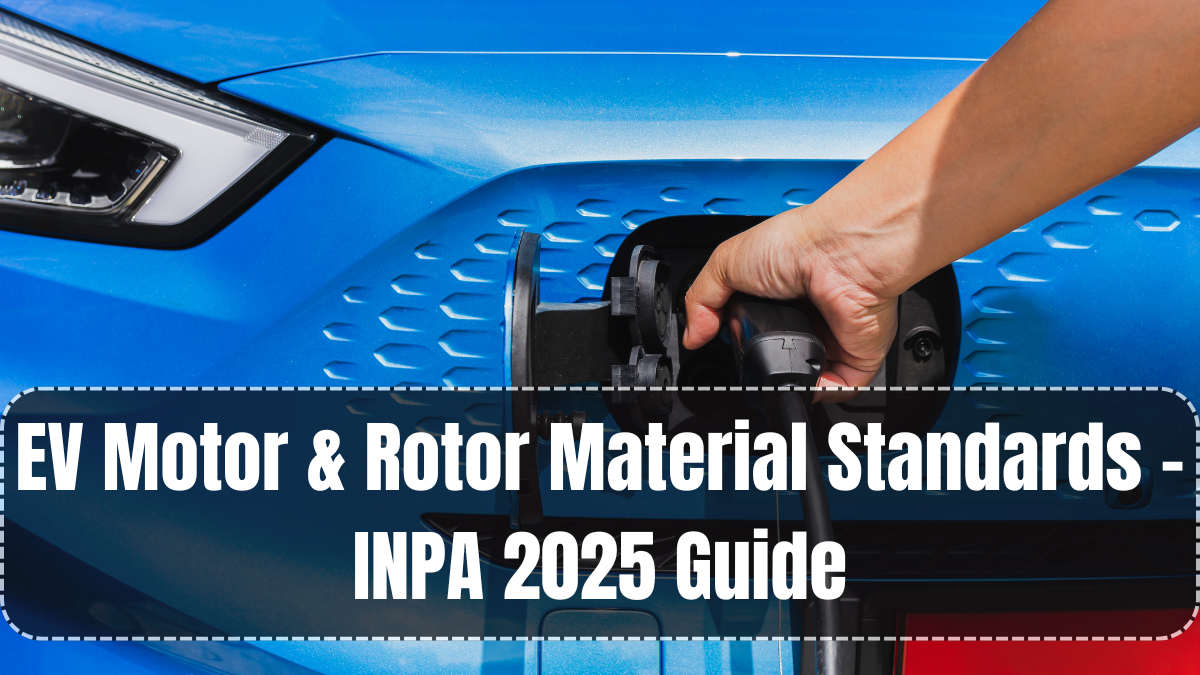As electric vehicle (EV) adoption surges across India, the INPA 2025 Material Standards for motors and rotors have taken center stage. The EV Motor & Rotor Materials Guide 2025 outlines strict benchmarks for manufacturers, suppliers, and quality auditors to ensure the durability and efficiency of electric drivetrains.
With India pushing to become a global EV hub, these standards aim to enhance not just the performance but also the longevity, recyclability, and safety of EV powertrain components.

Why the Focus on EV Motor & Rotor Materials in 2025?
Motors and rotors are the beating heart of any electric vehicle. INPA’s updated framework ensures:
-
Consistent magnetic performance under high stress
-
Thermal stability for long-distance and high-speed usage
-
Lightweight construction to improve vehicle range
-
Eco-friendly materials that align with future recycling mandates
The 2025 update directly impacts domestic EV manufacturing, CKD (completely knocked down) kit importers, and R&D labs building next-gen electric mobility solutions.
Key Material Requirements as per INPA 2025
The EV Motor & Rotor Materials Guide 2025 specifies acceptable materials based on performance, compliance, and availability. Here’s a breakdown:
Rotor Materials
-
Non-Oriented Electrical Steel (NOES): Standard for consistent electromagnetic performance
-
High-Silicon Iron Alloys: Improve core loss behavior and reduce heating
-
Aluminum or Copper Cast Rotors: Lightweight options with excellent conductivity
-
Magnet-retaining composites: Used in high-speed motors to secure permanent magnets
Motor Casing and Windings
-
Aluminum alloy 6061-T6: Strong and lightweight, ideal for heat dissipation
-
High-purity copper windings (≥99.9%): Ensure minimal resistance and energy loss
-
Epoxy or resin insulation: Heat-resistant and moisture-proof
These materials must undergo rigorous testing for magnetic flux, tensile strength, corrosion resistance, and fatigue under accelerated life cycles.
INPA Certification and Testing Requirements
As per the 2025 protocol, every EV motor and rotor material must be:
-
Sourced from approved vendors listed in the INPA registry
-
Tested in ISO-certified labs for insulation resistance, vibration tolerance, and structural strength
-
Labeled with QR-coded batch numbers for traceability and post-installation verification
-
Audited annually for continued compliance
Failing to meet these requirements may lead to blacklisting from OEM supply chains and government procurement contracts.
Impact on EV Manufacturers and Startups
These changes directly impact EV manufacturers in the following ways:
-
Increased R&D investment to source or develop compliant materials
-
Supplier diversification to meet new material standards
-
Greater export viability since these standards align with EU and North American benchmarks
-
Ease of homologation under upcoming EV policy frameworks in India
For startups, aligning early with EV Motor & Rotor Materials Guide 2025 ensures smoother entry into both commercial and passenger EV markets.
Future-Proofing Indian EV Ecosystem
With battery technologies improving, motor and rotor materials need to catch up. INPA’s 2025 framework supports:
-
High-speed EVs that can operate without overheating
-
Off-road and heavy-duty electric transport
-
EVs for Tier 2 and 3 cities that demand long operational life under rough terrain
-
Low-maintenance motors that reduce service downtime
These standards aim to build an EV ecosystem that is not only efficient but globally competitive.
FAQs
Are these EV motor and rotor standards mandatory?
Yes. All electric vehicle manufacturers in India must comply with INPA 2025 material standards for type approval and public sale.
Can older EV models be exempted?
Existing models may get a grace period, but all new models post-July 2025 must meet these material compliance norms.
How do I verify if my motor components meet INPA guidelines?
Check for the INPA QR code on packaging or request a digital compliance certificate from the manufacturer.
Are these standards aligned with international EV norms?
Yes. INPA’s 2025 framework aligns with ISO 9001:2015, ISO 26262, and EU ECE-R100 standards for EVs.
Will this increase production cost?
Slightly. While raw material costs may rise, compliant materials offer better life and performance, reducing long-term costs.
Click here to know more.
